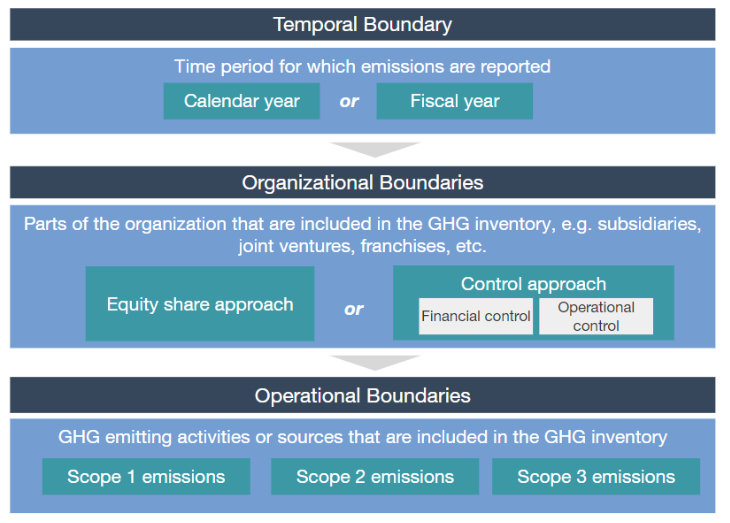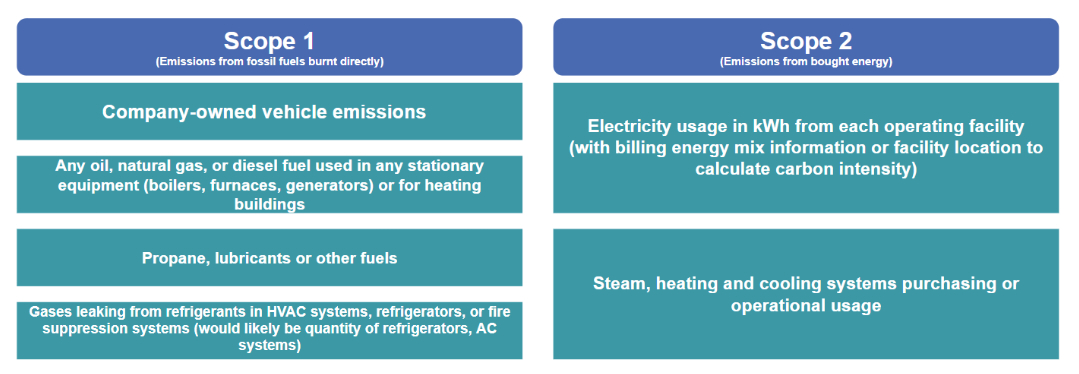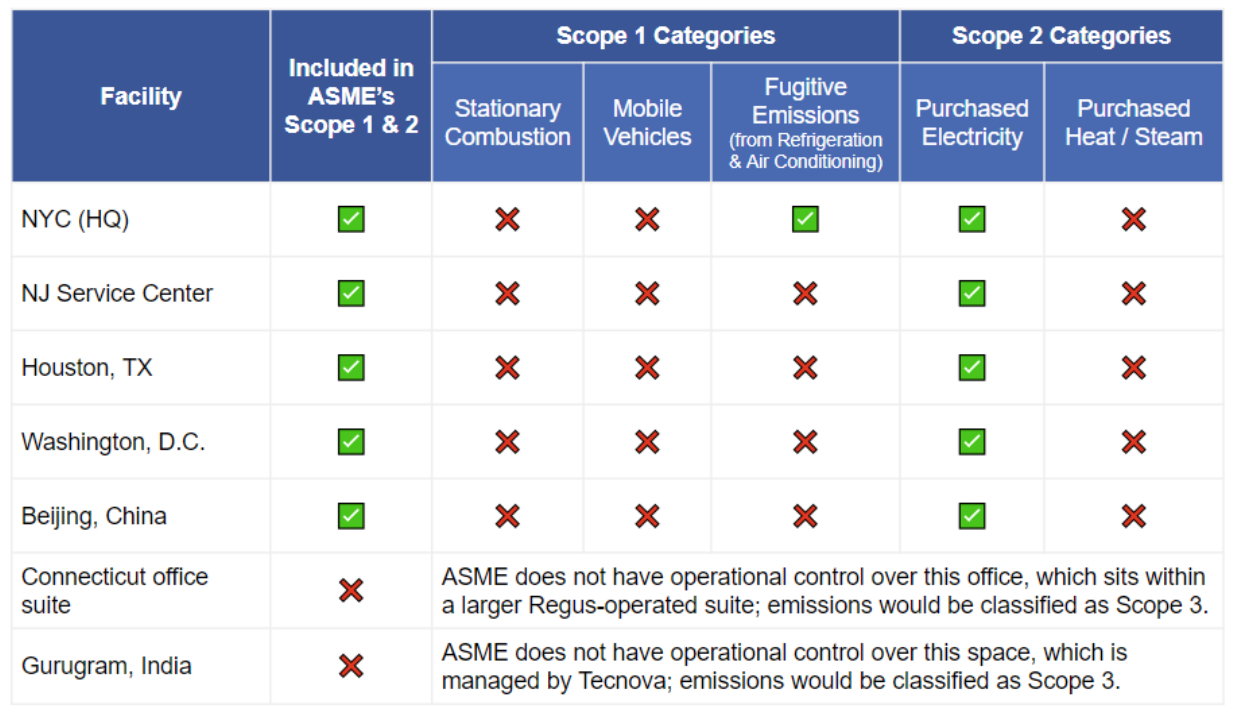ASME’s Greenhouse Gas Accounting Methodology
About GHG Accounting
The climate-warming greenhouse gas (GHG) emissions of an organization are classified into one of three categories, called scopes. Total GHG emissions are the sum of emissions of various gases: carbon dioxide (CO2), methane (CH4), nitrous oxide (N2O), and smaller trace gases such as hydrofluorocarbons (HFCs) and sulfur hexafluoride (SF6).
When companies and other organizations make plans to control their climate pollution, many start by sorting their activities into these different scopes. The three scopes and what they cover are as follows (credit: MIT Climate Portal):
Scope 1 emissions are GHGs a company puts into the atmosphere with its own properties and operations. For instance, when a company combusts fuel oil or natural gas to heat its buildings, the emissions created are CO2, CH4, and N2O. Those emissions belong in scope 1.
Scope 2 emissions are indirect GHG emissions associated with the purchase of electricity, steam, heat, or cooling.. These are “indirect” emissions that are generated at distant power plants. Still, as with scope 1 emissions, the company is clearly and solely responsible for them. If it used less electricity, there would be less demand for coal, gas and other fossil fuel energy sources.
Scope 3 emissions include all other indirect sources of GHGs from the company’s operations and products sold. These might relate to the day-to-day running of the company: for instance, if a company prints a magazine for its membership, the GHG emissions from the manufacture of the paper used would fall under scope 3. They might be upstream in the organization’s supply chain, like when a car company buys steel: manufacturing that steel creates some GHGs. Or the emissions might be downstream, like when a car company sells a car, which someone then fills with gas, creating more scope 3 emissions.
Key Highlights
- The total GHG emissions of ASME for FY23 was 4,026.14 tonnes CO2e.
- The value chain emissions (Scope 3) accounted for 93% of the overall emissions.
- Within the Scope 3 emissions, purchased goods and services was the key contributing category, representing 80.6% of Scope 3 emissions.
- Emissions from event-related activities was 587 tonnes CO2e, representing 15.6% of Scope 3 emissions.
Please see the global baseline report for our complete, top-line accounting.
Methodology
Initiation:
In July 2023, ASME initiated planning for an inaugural GHG emissions measurement exercise. With endorsement of Executive leadership, the ASME Sustainability Steering Committee (SSC)—a staff-secretariat—proceeded with a phased approach, starting with Scope 1 and 2 calculations for Fiscal Year 2023 (FY23). This initial phase ran from August through November 2023. Given time and resource constraints, ASME decided to phase-in Scope 3 calculations at a later date. All major steps in Scope 1 and 2 data gathering and calculations were done with the support from climate advisory firm OnePointFive (OPF).
In February of 2025, ASME began implementation of a GHG accounting software platform, Salesforce NetZero Cloud (NZC), to calculate its Scope 3 emissions for FY23.
All collected data was verified, cleansed and deemed complete and accurate before being imported into the carbon accounting software to generate ASME’s full baseline footprint comprising Scope 1, 2 and 3 emissions.
Process:
ASME aligned its approach to the GHG Protocol Corporate Accounting and Reporting Standard, which provides requirements and guidance for companies and other organizations preparing a GHG emissions inventory.
Leveraging the GHG Protocol Corporate Accounting and Reporting Standard enables ASME to:
- Prepare a GHG inventory that represents a true account of emissions through the use of standardized approaches and principles.
- Provide the enterprise with information that can be used to build an effective strategy to measure, report, manage and reduce GHG emissions
Boundary-Setting and Data Collection:
ASME established the temporal, organizational and operational boundaries to help guide the GHG emissions inventory data collection, calculation and analysis processes. The process is illustrated in the graphic below.
As with other major reporting activities, ASME will use its fiscal year as the temporal boundary, with July 2022 - June 2023 being the baseline year.
The operational control approach was used to set organizational boundaries. As a result, the following ASME facilities were included within the Scope 1 and 2 inventory:
- New York City - ASME HQ
- New Jersey - Service Center
- Houston, TX
- Washington, D.C.
- Beijing, China
ASME’s two offices in Connecticut and India were determined to not be operationally controlled by ASME. Consequently, emissions from these have been categorized as Scope 3 Upstream Leased Assets.
The GHG Protocol includes the following as potential emissions sources within Scope 1 and Scope 2 categories:
ASME set operational boundaries (i.e., determined the emissions sources to include in ASME’s Scope 1 & 2 GHG inventory), based on an assessment of the following, material categories using a detailed questionnaire:
- Facility Information
- Stationary Combustion
- Mobile Vehicles
- Refrigeration and Air Conditioning
- Fire Suppression
- Purchased Gasses
- Purchased Electricity
- Purchased Heat / Steam
- Across all in-scope office spaces, the landlord / building management controls and pays for heat generation, so Stationary Combustion and Purchased Heat / Steam are excluded from the inventory.
- ASME does not own or lease any vehicles.
- In the NYC office, air conditioner units were serviced and refrigerant fluid replaced in FY23, which generated fugitive emissions. Fugitive emissions are defined as climate-warming gasses that escape from containment, either as a leak or due to human intervention. Many common refrigerants possess a global warming potential hundreds and thousands of times greater than carbon dioxide.
- Where ASME does own or manage fire extinguishers on-site, the units are provided pre-filled by the supplier, so they did not generate fugitive emissions in FY23.
| Scope # | Scope Category | Type of Data Used for FY23 |
|---|---|---|
| 3.1 | Purchased Goods & Services |
|
| 3.3 | Upstream Fuel & Energy |
|
| 3.4 | Upstream Transportation & Distribution1 |
|
| 3.6 | Business Travel |
|
| 3.7 | Employee Commuting |
|
| 3.8 |
|
|
| 3.9 | Downstream Transportation & Distribution1 |
|
| 3.15 | Investments2 |
|
2 At the time of this publishing, this category is still in development; ASME expects to update its baseline footprint with Scope 3 Cat 15 Investments, once the results are available.
Notably, ASME also endeavored to calculate Indirect Emissions from Events & Conferences, given these make up a substantial portion of ASME’s business. ASME followed the U.S. EPA’s Indirect Emissions from Events and Conferences (2018), which was developed to guide organizations to account for emissions from events and conferences that they host or sponsor.
For this initial baseline footprint, ASME was able to calculate the following emissions sources tied to its FY23 events and conferences:
- Materials and services purchased for events (included within Scope 3 Purchased Goods & Services)
- Shipping of materials to events (included within Scope 3 Transportation & Distribution)
- ASME staff traveling to and from an event (included within Scope 3 Business Travel)
- Emissions from electricity at the event or conference venue; given challenges in collecting this data retroactively from venues, ASME instead used regional building energy intensity values to estimate the energy use for the duration of each event. Per the U.S. EPA guidance, this emissions source would fall outside an organization’s Scope 1-3 inventory, so this value is provided separately
Additional data collection will be required to calculate emissions from hotel stays by attendees, to be considered for future footprints.
The following Scope 3 categories were excluded:
| Scope # | Scope Category | Reason for Exclusion in FY23 |
|---|---|---|
| 3.2 | Capital Goods | Not relevant for ASME in FY23, however these will be monitored for relevance in future years |
| 3.5 | Waste Generated in Operations | |
| 3.10 | Processing of Sold Products | Not relevant for ASME |
| 3.11 | Use of Sold Products | Further development needed to collect required data; likely immaterial |
| 3.12 | End-of-Life Treatment | |
| 3.13 | Downstream Leased Assets | Not relevant for ASME |
| 3.14 | Franchises |
For each identified emissions source, the required supporting data was collected for the period of one year (July 2022-June 2023).
Calculation:
The Salesforce NetZero Cloud GHG accounting software platform was used to calculate ASME’s Scope 1, 2, and 3 emissions. Using this trusted accounting platform ensures consistency in results, speed of calculation, and visualization of trends. A tailored framework was developed for ASME’s business operations , aligned with the GHG Protocol Corporate Standard. This went beyond the requirements of the GHG Protocol, for example by estimating indirect emissions from the energy used at venues for ASME’s top events.
Next Steps:
With ASME’s full baseline footprint completed, the organization aims to maintain momentum by calculating emissions from FY24 and FY25, to strengthen initial findings with two years worth of additional data points. Once these final analyses are completed, ASME will develop a forward-looking emissions management plan and associated decarbonization strategy to reduce emissions tied to its primary hotspots.With this, ASME plans to launch targeted reduction initiatives across all scopes, establish an annual measurement and reporting cycle, and begin supplier engagement on sustainability requirements. As part of this, the organization will aim to improve data quality, completeness, and accuracy, prioritizing its most material emissions sources. Beyond 2026, ASME will continue improvements in its annual emissions measurement and reporting, track against its targets, and focus on industry collaboration and knowledge sharing.


